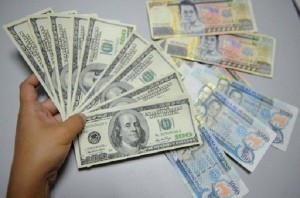Peso hits 4-year high on reports of 3rd stimulus from US Federal Reserve
MANILA, Philippines—The peso inched up to a new four-year high on Monday as market expectation of a third round of “quantitative easing” by the US Federal Reserve boosted appetite for emerging-market securities.
The local currency closed at 41.615 against the US dollar, up by 6.5 centavos from Friday’s finish of 41.68:$1.
Intraday high hit 41.54:$1, while intraday low settled at 41.62:$1. Volume of trade amounted to $804.5 million from $883.46 million previously.
Traders said the appreciation of the peso was triggered by the expectation of the market that the US Federal Reserve would implement a third round of stimulus, called QE3 (third quantitative easing), to boost the still lackluster performance of the US economy.
Quantitative easing is done by the US Fed’s buying of bonds to infuse money into the US economy.
Article continues after this advertisementAlthough infusion of funds by the US Fed is meant to boost growth of the United States, fund owners believe that portions of the liquidity could spill over to emerging markets like the Philippines. In particular, recipients of the cash from the US Fed may use it to buy emerging-market assets.
Article continues after this advertisementGiven this backdrop, fund owners see another round of stimulus raising demand for emerging market assets, thus causing appreciation of emerging market currencies.
Wanting to take advantage of the income potential from an expected appreciation of emerging market currencies, fund owners actually buy securities denominated in these currencies. As a result, currencies indeed appreciate.
The rise of the peso against the US dollar on Monday came with the appreciation of other Asian currencies against the greenback.
“The appreciation today was due to the stimulus bets on the US dollar,” Jonathan Ravelas, market strategist for Banco de Oro, told the Philippine Daily Inquirer.
Ravelas said the peso would likely hover between 41.6 and 41.8 against the US dollar in the coming days until the US Fed’s announcement of a QE3.
Speculation that the US Fed may implement another round of stimulus measure came following the release of a report that US payroll increased in August by 96,000, which was below most forecasts.
Unfavorable employment situation in the United States is one of the factors supporting the view that the US Fed may eventually be forced to implement QE3.
